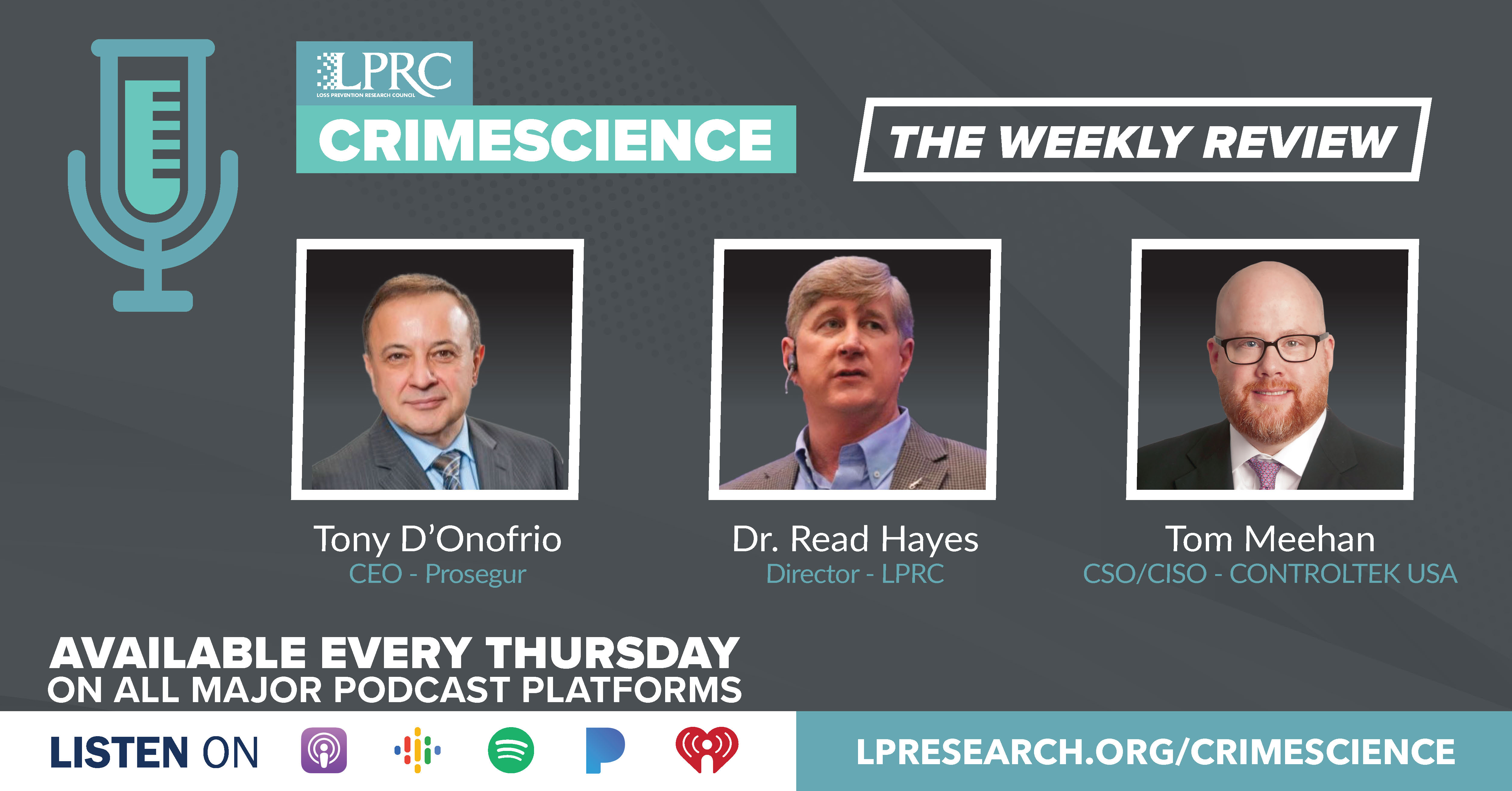Loss Prevention Research Council Weekly Series - Episode 157 - UK Theft Trends and USA LP Tech Usage
With Dr. Read Hayes, Tony D'Onofrio, and Tom Meehan

Shoplifting surges 26% across 10 of the UK’s Largest cities
https://www.theindustry.fashion/shoplifting-surges-26-across-10-of-the-uks-largest-cities/
Let me start this week with research from the UK published by Industry Fashion Online Magazine.
As they reported, new research from the British Retail Consortium (BRC) has revealed that incidents of theft have increased by 26% across 10 of the largest cities in the UK, with some cities seeing a rise of as much as 68%.
Major chains and supermarkets have been especially targeted by organised gangs as perpetrators have become bolder, building on the findings of the BRC’s most recent crime survey which showed incidents of violence and abuse against retail employees have almost doubled on pre-pandemic levels.
Incidents, which include racial and sexual abuse, physical assault, and threats with weapons, have also risen from the pre-Covid high of over 450 per day in 2019/20, to over 850 per day last year.
The BRC is once again urging the Government and police to take action and do more to protect workers as retail crime soars across the country.
Helen Dickinson, CEO of the BRC, said: “Every time I speak with retailers, crime is getting worse. Thieves are becoming bolder, and more aggressive. Violence and abusive behaviour are on the rise. Many employees are facing threats with weapons, physical assault, and racial and sexual abuse. While these confrontations might be over in a matter of minutes, for many victims, their families and colleagues, the physical and emotional impact can last a lifetime.
“Retailers are playing their part, investing nearly £1bn into crime prevention measures in the past year alone. But more needs to be done.”
Local Malls Stuck in Death Spiral, Plunge in Value
https://www.wsj.com/articles/local-malls-stuck-in-death-spiral-plunge-in-value-a7998b7d
Switching topics, let me to the United and some news published in the Wall Street Journal this week on what is happening to local / regional retail malls in the United States.
As they reported, Older, low-end malls are worth at least 50% and in some cases more than 70% less than they were when mall valuations peaked in late 2016.
Now, as more than $14 billion of loans backed by these properties comes due in the next 12 months, according to Moody’s Analytics, struggling malls are defaulting on their debt. With mortgage rates up sharply, refinancing that debt will be more challenging and expensive.
About a fifth of all malls financed through commercial mortgage-backed securities are underwater, meaning the properties are worth less than the loans they back.
Not all malls are on the brink of disaster. Newer, well-located properties with strong tenant rosters are generating healthy foot traffic and returns for investors. But even these high-quality malls have declined in value by an estimated 50% since 2016.
Widespread department-store closures beginning in 2018 hastened malls’ decline. Large mall anchors like Macy’s, Bon-Ton, JCPenney and Sears closed about 875 department stores between 2018 and the end of 2020, according to Green Street, compared with a combined 175 in 2016 and 2017.
How America’s biggest retailers plan to use technology to catch organized retail theft
https://www.cnbc.com/2023/07/29/how-americas-biggest-retailers-will-use-tech-to-catch-retail-theft.html
Switching topics to a new article from CNBC title “How America’s biggest retailers plan to use technology to catch organized retail theft”. This article featured great content from the Loss Prevention Research Council.
As they reported, Walmart, Target, Lowe’s, Kroger, Macy’s, CVS and other major retailers are teaming up with technology companies to develop and deploy next-generation video surveillance systems, facial-recognition cameras, license-plate and vehicle readers, autonomous security robots, radio-frequency identification (RFID) tags, smart case locks and predictive analytic software. While versions of this type of security tech have been in place for years, they’re now being superpowered by AI.
For retailers and loss-prevention experts, the primary goal of these technologies isn’t necessarily to catch thieves in the act, but rather to make committing their crimes less appealing — turning them away before they ever reach the door.
“The first thing we look at is, can we detect these people and identify them before there are victims?” said Dr. Read Hayes, director of the Loss Prevention Research Council, a think tank comprising researchers, retailers, technology companies, manufacturers and law enforcement professionals. “We’re trying to get the offender or crew to say, ‘Not here, not now, this doesn’t feel right.’”
Launched in 2000 with funding from Target and based at the University of Florida in Gainesville, the LPRC has tested hundreds of technologies in a simulation laboratory that recreates different retail environments, such as a checkout area in a big-box store, aisles in a home-improvement center or a shopping mall parking lot.
“We conduct large-scale experiments, much like randomized controlled clinical trials,” said Hayes, the son and grandson of physicians who sparked his interest in research.
Like high-tech scarecrows, preventive wizardry will ward off some criminals, but others fly right past it.
“Thieves want the easiest job possible,” said Dan Berthiaume, who covers technology for Chain Store Age. “If your store has some basic security protocols, they move on to a store that hasn’t been hardened.”
On a separate personal note, I have just announced a Future of Retail Day on October 18 where I will host experts from around the world on topics such as
- The Retail Consumer
- Silicon Valley Retail Startups
- Generative AI
- World and Retail Economics
- Intelligent Omnichannel Stores
- Retail Loss Prevention Function
- On-Shelf Availability
- RFID Internet of Things
- Computer Vision
- Retail Loss Prevention
- Department Stores
Speakers include senior leaders at Deloitte, IDC, our own Dr. Read Hayes from LPRC, experts in retail media, computer vision, RFID, and on-shelf availability, and a venture capital firm from Silicon Valley. You can see it all and register on my social media feeds.
On this week’s episode of CrimeScience, Dr. Hayes discusses new initiatives in Portland and with our SaferPlaces Lab both locally and with our partners, and our co-hosts discuss violence in retail and trends for this week, as well as media and social media updates with domestic companies working with Meta and Facebook.
















